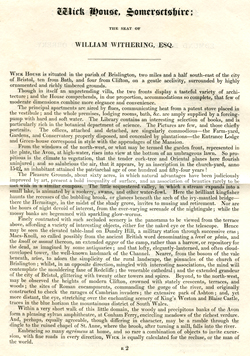Wick House c.1831

Click ^ for larger image.
The text is from an illustrated book of similar descriptions of many large houses occupied by people of rank and note, published in 1831.
Please note that whilst care has been taken to produce the transcript below, it's not guaranteed error-free and also, as its primary purpose is to make the contents of an image accessible as a machine readable text, certain nuances of the original may not be reproduced here - we always recommend referring to the original source wherever possible.
"Wick House, Somersetshire;
"THE SEAT OF
"WILLIAM WITHERING, ESQ.
"Wick House is situated in the Parish of Brislington, two miles and a half south-east of the city of Bristol, ten from Bath, and four from Clifton, on a gentle acclivity, surrounded by highly ornamented and richly timbered grounds.
"Though in itself an unpretending villa, the two fronts display a tasteful variety of architecture; and the House comprehends, in due proportion, accommodations so complete, that few of moderate dimensions combine more elegance and convenience.
"The principal apartments are aired by flues, communicating heat from a patent stove placed in the vestibule; and the whole premises, lodging rooms, bath, &c. are amply supplied by a forcing-pump with hard and soft water. The Library contains an interesting selection of books, and is particularly rich in the botanical department of science. The Pictures are few, and those chiefly portraits. The offices, attached and detached, are singularly commodious - the Farm-yard, Gardens, and Conservatory properly disposed, and concealed by plantations - the Entrance Lodge and Green-house correspond in style with the appendages of the Mansion.
"From the windows of the north-west, or what may be termed the garden front, represented in the plate, the Avon, at high water, rises into view at the bottom of an umbrageous lawn. So propitious is the climate to vegetation, that the tender cork-tree and Oriental planes here flourish uninjured; and so salubrious the air, that it appears, by an inscription in the church-yard, anno 1542, an inhabitant attained the patriarchal age of one hundred and fifty-four years!
"The Pleasure Grounds, about sixty acres, in which natural advantages have been judiciously improved by art, present a bold inequality of surface, and an association of beauties rarely to be met with in a similar compass. The little sequestered valley, in which a stream expands into a small lake, is animated by a rookery, swans, and other water-fowl. Here the brilliant kingfisher haunts the recesses of the babbling brook, or glances beneath the arch of the ivy-mantled bridge - there the Hermitage, in the midst of the shady grove, invites to musing and retirement. Nor are the hours of night devoid of interest, from the ever-varying serenade of the nightingale; while the mossy banks are begemmed with sparkling glow-worms.
"Finely contrasted with such secluded scenery is the panorama to be viewed from the terrace above, affording a variety of interesting objects, either for the naked eye or the telescope. Hence may be seen the elevated table-land on Dundry Hill, a military station through successive eras; Maes-Knoll, so called possibly from the ancient British word denominating a level or plain, and the knoll or mount thereon, an extended agger of the camp, rather than a barrow, or repository for the dead, as imagined by some antiquaries; and that lofty, elegantly-lanterned, and often cloud-enveloped tower, the well-known landmark of the Channel. Nearer, from the bosom of the vale beneath, arise, to adorn the simplicity of the rural landscape, the pinnacles of the church of Brislington; whilst, in an opposite direction, mingled with interesting associations, the mind will contemplate the mouldering fane of Redcliffe; the venerable cathedral; and the extended grandeur of the city of Bristol, glittering with twenty other towers and spires. Beyond, to the north- west, may be observed the heights of modern Clifton, crowned with stately crescents, terraces, and woods; the sites of Roman encampments, commanding the gorge of the river, and originally constructed to check the ravages of Cambrian invaders; the extensive park of Ashton; and, yet more distant, the eye, stretching over the enchanting scenery of King's Weston and Blaise Castle, traces in the blue horizon the mountainous district of South Wales.
"Within a very short walk of this little domain, the woody and precipitous banks of the Avon form a pleasing sylvan amphitheatre, at Conham Ferry, encircling meadows of the richest verdure. And, perhaps, equally agreeable, though differing in character, may be a ramble through the dingle to the ruined chapel of St. Anne, where the brook, after turning a mill, falls into the river.
"Embracing so many agrémens at home, and so rare a combination of objects to invite excursion, with fine roads in every direction, Wick is equally calculated for the recluse, or the man of the world."
The text was published in or around 1831 by Jones & Co. Temple of the Muses, Finsbury Square, London (probably in a volume of "Jones' Views of the Seats, Mansions, Castles, etc. of Noblemen and Gentlemen in England".
Period: Modern
Exhibit contributed by Ken Taylor
Text written by Ken Taylor, 2022 (including transcript)
Photographer: derivative image (scan) by Ken Taylor, 2022
Acquisition number: 220102a3